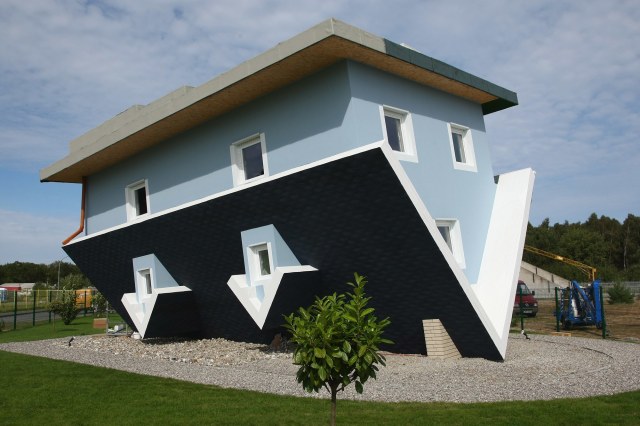“The World Stands on its Head” (Photo by Sean Gallup/Getty Images)

When it comes to matters of architectural style, the professionals have just one message for the politicians: mind your own business.
But is architecture architects’ business alone? It’s us who must live with (or possibly in) what gets built – so why shouldn’t our elected representatives represent us?
That would present a problem, though. How are politicians to adjudicate between the conflicting aesthetic preferences of their constituents? After all, one person’s ‘bold architectural statement’ is another’s monstrous Carbuncle.
In the American Conservative, Nick Phillips shows us how there’s a great deal more consensus than we’re led to believe:
“In The Architecture of Community, a brilliant, baffling book that contains equal parts text and the architectural equivalent of political cartoons, traditionalist architect Leon Krier opens with a simple proposition. Imagine that you had to choose between eliminating every building built before 1945 or every building built after 1945. Which would you choose? The total built volume of both periods is about the same—so which act of destruction would feel like the greater loss?”
It’s a great, if very hypothetical, question. As Phillips says, what makes it so interesting is that “it should be a hard question, but isn’t”.
Even if one discounts the historic significance of the older set of buildings, their collective artistic worth – and the joy they bring to us today – is streets ahead of the newer set. But don’t take my word for it:
“Whenever anyone bothers to ask the American people about what kinds of buildings they prefer, they speak with a clear voice: They prefer traditional ones. In 2006, the American Institute of Architects decided to survey the general public for their view on the question, producing a ranked list of ‘America’s Favorite Architecture.’ The list is remarkable: Of the 50 most favored buildings, a mere seven were built in postwar styles. Of those seven, two are monuments (the Vietnam Veterans Memorial and the Gateway Arch) and another, the World Trade Center, no longer exists.”
And that’s just America, which, compared to Europe, has a limited endowment of older buildings.
Perhaps what is most damning of modern architecture is not the (positive) reasons for voting for pre-1945 architecture, but the (negative) reasons for voting against post-1945 architecture. Erasing the latter would mean the loss of some great buildings, but think how much soul-destroying dreck we’d be rid of too. It would certainly soften the blow.
The same can’t be said the other way round:
“For thousands of years, we built beautiful things. It is close to impossible to find a pre-20th century building capable of conjuring strong negative feelings—the worst they can evoke is indifference.”
What, though, of the argument that the bad old buildings are all gone – and therefore we have an unrepresentative sample left to judge from?
There’s a grain of truth to this. I recently saw some photographs of 19th-century London – including whole streets of rather ramshackle, shed-like buildings. However, the deficiencies were down to a lack of money, not a lack of architectural good sense. Where the working class housing of the pre-modernist era survives to the present day, it is keenly sought after.
It’s remarkable how our ancestors built entire neighbourhoods without the guidance of planning professionals or the cultural correctness of modernism – and yet created communities that still work so well that we’ll pay over the odds to live in them.
Perhaps as politicians seek to persuade us of the need for more housing, they could trust the public with the final say – not over whether new homes get built, but over what they look like.










Join the discussion
Join like minded readers that support our journalism by becoming a paid subscriber
To join the discussion in the comments, become a paid subscriber.
Join like minded readers that support our journalism, read unlimited articles and enjoy other subscriber-only benefits.
Subscribe